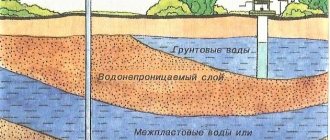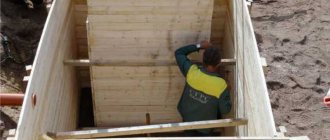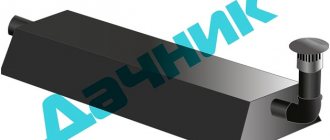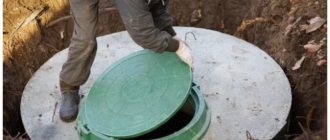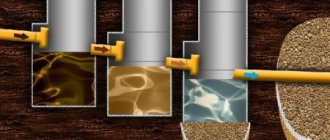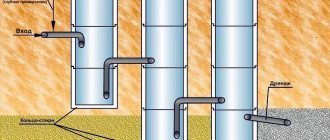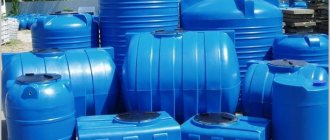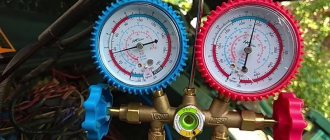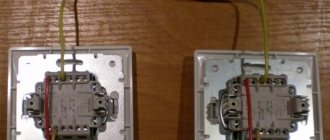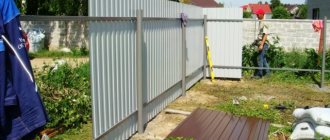People who are little familiar with the operation of treatment facilities often have questions about how the septic tank will work in the winter. Let's consider the principles of operation of such structures and the features of their operation in severe frosts.
Septic tanks are engineering structures used to treat domestic waste water and used in private housing construction in the absence of a centralized sewer network. The principle of their operation is to settle waste under its own weight and purify it using biofermentation using preparations containing biologically active bacteria. Additional cleaning is carried out using natural soil and forced methods. In English the word is translated as “putrefactive”, “purulent”, which well reflects its essence.
A septic tank in winter can be operated in the same way as in summer with the same efficiency of wastewater treatment.
How does he work
All used water and wastewater flows from the house through pipes into the septic tank. There they settle and undergo primary purification with the help of special microorganisms. At the end of this process, the wastewater can be transported to filtration fields.
According to the technology, the tank goes deep into the ground to a depth of one and a half to two meters, this is enough to avoid the need for additional insulation. Indeed, in most of Russia, the ground simply does not freeze that deeply. In addition, a small amount of heat emanates from the container itself, generated due to the activity of bacteria and chemical reactions during the decomposition of organic substances.
In any case, it is worth taking care of sufficient thermal insulation of the pipes connected to it, since they do not lie so deep and can freeze even in slight frosts.
But if for some reason the container is on the ground or you live in a region where the thermometer drops significantly below zero, then it is necessary to insulate the septic tank in advance.
What to do if the system is frozen?
There are several ways to defrost a drain.
- pouring boiling water. Using a rubber hose inserted into the pipe and a funnel, boiling water is poured. The hose should rest against the ice plug. When the plug melts, the hose is pushed through the pipeline to completely dissolve the ice.
- flushing with saline solution. Having heated the water to 70 degrees using the boiler, open the tap and drain the water into the bathroom. Pre-dissolve salt in it (1:10). We wait half an hour. If the ice plug has not thawed during this time, you should use the following method.
- heating the pipe. Using a construction or household hair dryer, heat the section of the pipe that goes outside.
- caustic soda. This method should help if the traffic jam does not form near the house, but closer to the system. Mix caustic soda (3 kg), hot water (6 l), boiling water (1 l). Pour the mixture down the drain. The large amount of heat from the chemical reaction should melt the cork. This will be noticeable if the mixture begins to flow freely into the drain. You should work in a respirator, gloves and goggles.
- heating the pipe with excavation of the route. If none of the previous methods gave results, then you should use this method. To determine where the plug formed, we dig a trench. Next, using a mallet, tapping the pipe, we find out the location of the ice. The area with the congestion is heated with a hair dryer.
Is it possible to install a treatment plant in winter?
Surprisingly, many experts advise installing a wastewater treatment plant in winter. Installing a septic tank in winter has the following advantages:
- Since construction and renovation work stops during this period, you won’t have to wait for a specialist. Also, the masters will be able to give you maximum attention.
- It is better to install a septic tank in winter for the reason that the groundwater level during this period decreases to a minimum, so digging a pit and a trench for the supply and drainage of wastewater will not arise.
- In principle, there is no difference when installation work is carried out. The only problem may be unfavorable weather conditions.
- Since no one lives at the dacha in winter, the work will not bring any inconvenience to the household.
- In winter, discounts often appear on many building materials and services provided, so you can save money.
Installation of a septic tank in winter is carried out in the same sequence as at other times of the year:
- First, a pit and trenches are dug for the supply sewer pipeline and the discharge of treated wastewater.
- After this, sand cushions are made at the bottom of the pits, which are then compacted.
- A septic tank is installed, a pipeline is laid and connected.
- The pit and trenches are backfilled.
How and how to defrost a sewer in a private house
There are different ways and means to warm up a frozen sewer (than to melt the ice in a pipe). All methods can be combined into two large groups:
- thermal method . Provides for the organization of heat supply to the freezing point. The work is progressing slowly, but there is no risk of causing damage to the pipeline system. This method is most suitable at home, when special means are not at hand, and calling specialists is impossible or too expensive;
- chemical method . Currently, chemical defrosting is rarely practiced. Firstly, because not every chemical can cope with icing. Secondly, because this is a costly method. And thirdly, because many users prefer local sewers, i.e. systems that are capable of performing partial wastewater treatment.
Mellerud pipe cleaner, chemical defrosting One of the components of local systems is the presence of biological treatment, and chemistry can negatively affect the life of bacteria. However, its simplest variety, a steep saline solution, is still used, according to reviews.
A more technologically advanced option is to use a drug like Mellerud. The components of Mellerud pipe cleaner react with water to produce heat.
Note. You should carefully use a chemical method to defrost plastic sewer pipes. Because Severe overheating can cause them to deform.
Conservation of septic tank Topas
Activated sludge contains bacteria that consume human waste, convert it into harmless substances, and then can be used as fertilizer. If you completely drain the water from the septic tank for the winter, then a critically low temperature below -15 ᵒC can completely destroy all existing living flora.
In addition, in the spring, an empty tank can be torn from the foundation by the lifting force of groundwater and raised to the surface, which will lead to complete failure of all equipment.
How to clean a Topas septic tank
All purchased Topaz septic tank models are supplied with detailed instructions on how to prepare the septic tank for winter. Popularly it can be stated as follows:
1. First of all, the installation must be completely disconnected from the electrical network at the main electrical distribution panel. If the design allows, it is advisable to lock the switchboard to avoid accidental switching on, which can lead to electrical injury.
2. All chambers of the septic tank and the filter are cleaned of solid, undecomposed residues. The activated sludge remains intact in the chamber so that bacteria do not die.
3. All removable electrical equipment, such as a compressor for water aeration and a sump pump, is turned off and dismantled.
3. The level of water that remains in the septic tank for the winter must be at least 75% of the optimal level. Excess water must be pumped out, and the missing water must be added from the water supply network.
4. Even with careful insulation, water may freeze. To prevent the formed ice from crushing the septic tank, plastic bottles can be placed in the water. They are filled with sand to 1/3 of their volume in order to take a vertical position. Each bottle is tied with a rope to the body of the septic tank so that they can be easily removed in the spring.
5. The septic tank lid is carefully insulated. For this, polystyrene foam, sawdust, hay and straw are used. The insulation layer must be covered with plastic film or other similar material. In this case, it is imperative to ensure active air exchange inside the tank in order to support the vital activity of bacteria. You can make small holes in the foam.
6. How to insulate a septic tank for the winter determines its performance for the entire summer period. The main thing is to preserve the vital activity of bacteria.
Location of elements of the Topas septic tank
Preservation of septic tank Unilos
In this case, the algorithm of actions is approximately the same. First of all, the stabilizer tank is cleaned or from various solid residues that cannot be decomposed. Considering that septic tanks from this manufacturer are intended for use all year round, then such cleaning must be performed periodically.
Preservation of the Unilos septic tank for the winter
The water level is brought to 1/3 of the total. All existing equipment is disconnected from the power supply, dismantled and placed in a warm place.
The maintenance hatch can be insulated in any way, but air circulation inside the septic tank must be ensured so that bacteria do not die. In case of possible freezing of water, it is necessary to perform approximately the same measures as in the previous version.
Preservation of septic tank Astra
These cleaning plants are equipped with a special device called an airlift. With its help, you can clean the tank from silt and other sediments. Therefore, before conservation, this procedure is performed without much difficulty.
Using a drainage pump, the septic tank stabilizer is cleaned and the filter is washed. The power is turned off and electrical equipment is dismantled. The septic tank lid is insulated using all available means.
Astra septic tank diagram
High-quality and timely conservation ensures long-term operation of such devices. Only specialized enterprises can provide full preparation for the winter period, which, for a relatively small fee, will carry out all the work in accordance with the regulations.
Useful tips for preserving a septic tank for the winter
Local treatment facilities in the form of an inventory septic tank are a rather complex device. Therefore, after the installation has been installed and put into operation, it is advisable to carefully study the attached installation and operating instructions.
All manufacturer’s recommendations must be followed strictly so that you can operate the Tver septic tank in winter and summer without unwanted breakdowns.
The most affordable insulation materials for installing a septic tank
- expanded clay (durable up to 30 years of service)
- sprayed polyurethane foam (durable insulation from 15 to 25 years of service)
- sand (durable insulation but due to moisture it loses its quality)
- foam glass (durable insulation with unlimited service life)
- polystyrene foam (durable insulation, but due to damage by rodents only up to 20 years of service)
- penoplex (the insulation is durable, but due to damage by rodents only up to 20 years of service)
- mineral wool (not durable up to 10 years of service);
- extruded polystyrene foam,
The presence of insulation will ensure normal drainage from the septic tank in cold weather, eliminating its freezing. In winter, water from the septic tank can be drained into a special drainage well.
How to properly preserve a septic tank for the winter
If the cleaning station was purchased ready-made, it should be accompanied by instructions with a detailed description of the winter preservation of the septic tank. Here is the sequence of actions that are recommended to be performed:
- First you need to de-energize the station. To do this, you need to use an automatic switch mounted somewhere in the house and/or press the on/off button directly on the station body.
- After this, you need to remove the air compressor. Since this device is mounted in the working compartment of the station using special clips, it will be quite easy to disconnect it.
- If the treatment station is equipped with a forced discharge system, it is necessary to dismantle the pump with which clean water is removed from the system.
- Then you need to check the liquid level in the septic tank. The optimal loading size for a septic tank before winter storage is ¾ of the total volume.
- If the amount of liquid in the septic tank does not reach this value (which happens quite often), you need to add regular water to the container to make up for the missing volume.
- All that remains is to insulate the septic tank lid by placing a layer of insulation (for example, polystyrene foam or expanded polystyrene) under a layer of stones hiding the septic tank lid.
The last point is not necessary if the winters in the area are not severe. A properly preserved and insulated septic tank will survive the winter cold without much damage to its inhabitants, since the temperature of the liquid inside the system will remain quite high.
The process of insulating the septic tank lid is presented in more detail in the video:
Some more useful tips for owners of industrial septic tank models:
- if the treatment station is equipped with a sludge stabilizer with a built-in air lift, it is recommended to clean this section before preserving the septic tank;
- the receiving chamber of the septic tank should also be cleared of solid accumulations;
- if you don’t have polystyrene foam on hand, insulate the cover of the treatment station with other suitable materials, for example, dry grass, straw, mulch, etc.
Please note that conservation of the septic tank should begin closer to winter, when the soil is cold, perhaps slightly frozen. This will slightly reduce the impact of changes in the soil caused by cold weather on the septic tank.
When preserving industrial septic tanks, you should turn off the power to the device and remove all electrical appliances. They are usually mounted in accessible places; dismantling requires minimal time and effort.
Some owners are concerned that an ice crust will appear inside the plastic container on the surface of the liquid and damage the walls of the septic tank. These concerns are justified only in areas with a sufficiently large depth of soil freezing. To prevent such a nuisance, you should make several floats for the septic tank. Making them is very simple:
- Find several plastic bottles with a volume of 1.5-2 liters.
- Pour a little sand into each bottle so that part of the float remains on the surface when immersed in water. In this case, the bottle must maintain a vertical position.
- Tie a long rope to the neck of each float.
- Lower the floats into the container.
- Secure the rope so that when the septic tank is re-opened, the floats can be easily removed.
These simple steps will protect the septic tank from damage even during very severe frosts.
Features of pumping out pulp in winter
As a rule, operating reservoirs rarely freeze in winter. The effluent is warm, and fermentation and decay processes occur in the pulp mass, during which heat is released. However, if the region experiences severe frosts, the waste may freeze. Some septic tank models have an electric heating function that allows you to keep the pulp in a liquid state. If this is not possible, the container is heated using a steam generator. After this, you can pump out in the usual way. The process does not take much time, so the pulp usually does not have time to freeze.
In any case, the home owner needs to anticipate the possibility of waste freezing and schedule cleanup for warmer days. If the container does not require frequent pumping, the procedure is performed in the fall and spring. If the tank volume is small, you have to calculate the schedule to avoid the coldest days.
The ability of waste to maintain above-zero temperatures depends on adherence to technology during system assembly. If the installation of sewerage in a private house in winter was carried out according to the rules, the pulp will freeze only when extreme cold occurs. The septic tank and supply pipeline must be properly insulated. In general, installation of sewerage systems in winter is a rather controversial issue on which there is no consensus among experts. Let's take a closer look at it.
Also read: SanPiN sewerage: sanitary requirements, standards
Technology for spring re-preservation of a septic tank
In the spring, the septic tank must be properly re-opened. To do this, almost all operations that were carried out during conservation should be done in reverse order:
- remove the insulation layer;
- remove the floats;
- install pumps, compressors and other equipment;
- connect power supply.
After this, the septic tank can be used as usual. After a few days of normal use, the system will return to normal. Usually there is no need to introduce new bacteria into the septic tank.
All owners of autonomous treatment facilities know that inside plastic tanks live living bacteria (aerobic and anaerobic), which help purify wastewater so much that it can be used for watering a garden or as process water. However, the septic tank is often left unattended in winter if you leave the dacha, or if you live in the house all year round, it is exposed to low temperatures. What happens to the microscopic workers of this structure? And how to protect them and wastewater from freezing in winter? Some owners are interested in the question of how to install a septic tank that will work in winter, or how to build this structure in winter? You will find answers to these and many other questions in our article.
Some owners, fearing that the septic tank would freeze in winter, made one big mistake - they completely drained the wastewater from the treatment plant and pipeline. Most likely, they did this by analogy with the heating and plumbing system, fearing that if the water froze, the plastic tank would expand and rupture. You shouldn’t do this, because the result will always be sad:
- If you return to your dacha in the spring, you will find your septic tank on top, floating in the pit. The thing is that during a flood, groundwater will easily push an empty container upward, since its volume is quite impressive and its weight is small.
- But worse could happen. Since the soil in which the tank is dug is not static, it can move as a result of temperature changes and changes in groundwater levels. During this process, the septic tank will experience significant loads. As a result, the autonomous sewerage tank will simply burst or become deformed.
As a result of this, the septic tank in winter will become unsuitable for further use. Owners will need to replace the damaged product, buy a new septic tank and install it, which will entail considerable expenses.
Details
How to insulate a system
For thermal insulation of a septic tank at a summer cottage, sawdust, leaves, and straw are used. To strengthen the material, cobblestones are placed on top. If the treatment plant is built from bricks, concrete rings, or plastic tanks, then other methods for insulation are required. The devices last for many years, so the materials must withstand a long service life so that they do not have to be replaced frequently. For example, straw may rot.
There are main methods that are used as insulation:
1. The septic tank is filled with expanded clay, which is based on clay. The material consists of porous granules of different sizes. Expanded clay has good qualities for use, it does not rot, does not allow fungus to form, and at the same time has an affordable price. Expanded clay is also resistant to moisture, has a long service life, and insulates the structure well. The material should be poured into the space between the septic tank and the soil in a layer of more than twenty centimeters. It is important to strengthen the insulation in the place where the sewer pipe enters the container.
2.Use mineral wool. It is easier to install cotton wool than to use expanded clay. The material insulates the septic tank at a high level, is resistant to chemicals and temperature changes. If the material is subject to external influence, then it retains its qualities, but mineral wool quickly absorbs water. A waterproofing film must be placed on top of the material. Mineral wool comes in the form of sheets that are attached to the septic tank with glue or dowels.
3.Use of extruded polystyrene foam. The material is resistant to temperature changes, is not afraid of moisture, and is easy to attach to a septic tank because it is light in weight. Expanded polystyrene is attached to the outer wall of the device with dowels or coy. Polyurethane foam is used to treat joints between strips of material.
4.Use of polyurethane foam. The material is considered one of the most commonly used insulation materials. This insulation has different forms because it is used in different areas of construction. It is produced in the form of blocks, rolls, sheets. The material is durable and strong. Does not form mold due to humidity, withstands external influences without forming cracks. At the same time, the material is very cheap, but heats well.
5. Install the heating cable. If a septic tank is used in regions with a harsh climate, then this measure is justified. With the help of a heating cable, the septic tank will withstand any temperature changes. It is installed in septic tanks powered by aerobic bacteria. The entire system should be insulated using sheet or bulk material, and the cable itself should be protected from moisture.
In addition to the cleaning device, the pipeline should be insulated. The pipes are wrapped in mineral wool material, and waterproofing is placed on top of the mineral wool. The waste pipe is fixed using a foam insulating box. If the soil settles, the pipe will not change its angle of inclination.
When insulating with your own hands, you must adhere to some rules:
1. The thickness of the insulating layer depends on the climatic characteristics of the region, the composition of the insulation, and the depth of the septic tank in the ground.
2. if the septic tank is located in the northern region, then insulate the septic tank from the sides, from above.
3. when insulating a pipe entering a septic tank, you should remember that the pipe can freeze, even if it is correctly laid at an angle. The diameter of the pipe may be reduced to a minimum size.
4. if the septic tank is used at the dacha only in the summer, it should be preserved for the winter.
How to preserve the device
If you use a septic tank only in the warm season, you should preserve the device for the winter. The procedure will reduce the negative impact of frozen earth on the walls of the septic tank.
Attention! Before conservation, there is no need to drain all the drainage from the septic tank, so that in the spring groundwater does not push the structure out of the hole, or the septic tank does not crack when the soil layers are displaced.
The conservation procedure can be carried out by specialists. Then you won't have to worry about doing something wrong. You can also do the preservation yourself, following the instructions in the instructions for the septic tank.
The following sequential steps must be followed:
1. The septic tank is disconnected from electricity, the air supply pumps are disconnected. These actions are not difficult to carry out, because there are special fasteners in the tank for this.
2. Three-quarters of all drains are drained of liquid from the septic tank, or water is added if there is a shortage.
3. insulation of pipes and septic tank lids is carried out.
Attention! Thirty days before storing the device, a product based on aerobic bacteria must be added to the septic tank. They will break down solid particles settled at the bottom of the chamber and eliminate odors. With proper conservation, the septic tank will maintain a warm temperature all winter, and the autonomous sewage system will not be affected.
Rules for preserving a wastewater treatment plant for the winter
If you are using a ready-made factory cleaning product, then it must be accompanied by instructions that describe in detail how to preserve the septic tank for the winter. If for some reason you cannot study the instructions, then you can use our tips on how to preserve the cleaning device for the winter:
- First of all, the volatile station must be de-energized. To do this, you can use a machine installed inside the house, or turn it off using a button on the unit itself.
- Now you can remove the air compressor. This product is fixed in the working compartment of the treatment plant using special clips, so you can disconnect it with your own hands.
- If water is drained from the station forcibly, then it is necessary to dismantle the pumping equipment. You can also remove the pump that drains purified water with your own hands.
- After this, the water level in the septic tank is checked. This can be done using a rope or other improvised product. For proper winterization of the sewer system, the water level in the treatment plant must be at least ¾ of the total volume.
- If there is too much liquid in the tank, then it is worth draining wastewater from the tank. But more often it happens that there is slightly less water than required for wintering, so it will have to be added.
- Finally, it is necessary to carefully insulate the cover of the sewerage system. This can be done with penoplex, polystyrene foam or polystyrene foam. A layer of stones is laid on top of the heat-insulating material, reliably fixing the lid.
If the winters in your region are not very severe, then the lid does not need to be insulated. Proper preservation and insulation of the septic tank will help the microscopic inhabitants of the treatment plant survive the winter cold, since the temperature in the tank will remain quite high (+4°C). This ensures that the septic tank does not freeze in winter.
The following tips will be useful to owners of factory deep cleaning products:
- If the septic tank has an activated sludge stabilizer with a built-in air lift, then this section must be thoroughly cleaned before conservation.
- The chamber into which the waste flows directly from the sewer must also be cleared of solid deposits at the bottom.
- To insulate the lid, you can use available materials - dry grass, mulch, straw, etc.
- Preservation can begin with the onset of cold weather, when the soil is slightly frozen. This will reduce the impact of soil deformation movements on the reservoir.
In regions where the depth of soil freezing is significant, an ice crust may form on the surface of the water in the septic tank, to prevent this from happening, you can do the following:
- You should take several PET bottles with a volume of 1.5 to 2 liters.
- Sand is poured into the bottles half the volume. This will allow it to float like a float in a vertical position when immersed in water.
- We tie a rope to the neck of each float bottle.
- We lower the products into a tank of water.
- We fix the ends of the rope to the surface so that in the spring you can easily remove the container from the tank.
Conclusions and useful video on the topic
A master installer of a wastewater treatment plant can clearly show and tell you whether septic tanks “Topas”, “Astra”, “Biodeka” freeze in winter, how to properly prepare them for work in winter and preserve them during cold weather.
By following the technology for installing the sewer system, strictly following the manufacturer's recommendations, properly insulating them and preserving them, if necessary, the likelihood of freezing of the treatment plant can be minimized in most cases.
What if you still need a septic tank in winter?
According to experts, winter conservation of a septic tank only makes sense if the house is left unattended for more than one month
And if the dacha is still visited every 2-3 weeks, the treatment facilities will overwinter just fine without special precautions
For example, the same one calmly tolerates the absence of drains for two weeks, the bacteria remain alive, active and multiply quite successfully. The energy consumption of such a system is not at all high, so the bills for the electricity used by the septic tank will not bankrupt the owners, and the level of comfort at the dacha will remain the same.
What does reactivation of a septic tank include?
- dismantling temporary insulation used during conservation;
- removing plastic bottles with sand if they were immersed inside the tank;
- installation of dismantled electrical equipment in its original place, its connection, configuration for further work;
- connecting power to electrical systems;
- checking the functionality of the septic tank or its individual elements.
There are several recommendations on how to optimally reactivate a septic tank and quickly restore its functionality.
- If there is floating debris inside, you need to remove it from there and check the operating fluid level. If it is less, add it; if the tank is filled during snow melting, pump out the excess liquid.
- It is better to start work on starting a septic tank in advance - a couple of days before they begin to actively use it.
- After the sewer system is put into operation, it should not be loaded to its maximum for the first 2-3 days. This time is needed for the required amount of useful sludge to form. After this she will be able to work at full capacity.
- You need to check the drain well to make sure it is not full. Clean it if necessary.
- If you follow the recommendations listed above, the functioning of the septic tank at your dacha in winter and beyond will be problem-free.
Cheap option for insulating a septic tank
It is not necessary to invest large amounts of money on insulating a septic tank. After all, it is quite easy to cope with such a task using cheap materials.
This section of the septic tank is the most delicate. Organic materials are not suitable for its insulation due to their short service life. Indeed, straw and sawdust retain heat very well. But they quickly deteriorate, thereby losing their beneficial qualities. The summer resident will have to regularly replace rotted material to prevent the septic tank from freezing in the cold.
Expanded clay - a cheap insulation option
Expanded clay allows you to save your family budget. It is famous for its thermal characteristics. And the price for this material is quite low. Another advantage of expanded clay is its naturalness and lightness. With its help, the summer resident will be able to insulate the pit on his own. For expanded clay to be beneficial, it should be laid in a layer of at least 20 centimeters. They are recommended to tightly fill the upper part of the septic tank, as well as the conducting pipe.
How to insulate a septic tank
If there is a possibility of drains freezing, then proper insulation of the septic tank will help you in this difficult task. But what kind of insulation is best to use for a septic tank, you will find out further.
Polystyrene foam will not work because it tends to absorb moisture, which is an excellent heat conductor and the situation will only get worse. For the same reason, when deepening, you should not sprinkle the tank with expanded clay to insulate it. Since this mineral is destroyed quite quickly under soil pressure, as well as from exposure to moisture.
When insulating any septic tank with your own hands, experts recommend using special insulation materials. Extruded polystyrene foam Penoplex will cope best with this task. It has very low thermal conductivity and zero moisture absorption, which allows you to reliably protect the septic tank from freezing. It is also perfect for insulating concrete rings and for insulating plastic Eurocubes.
For additional safety, it is also necessary to insulate pipes with special materials, since, as practice shows, they are the weakest link in the drainage chain in winter.
When thermally insulated with Penoplex, the sewage system will properly perform its functions even in the most severe frosts.
Advantages of Penoplex when insulating a septic tank
Penoplex has a number of advantages over other types of thermal insulation materials:
- has low thermal conductivity,
- does not absorb moisture at all,
- ease of use - all manipulations for thermal insulation of a septic tank can be easily done with your own hands,
- durable - service life more than 50 years,
- environmentally friendly - does not contain phenol resins and is produced without the use of freon,
- safe - completely non-flammable material.
Take care in advance about high-quality thermal insulation of the sewer system and you will not have to think about its operation throughout the winter!
